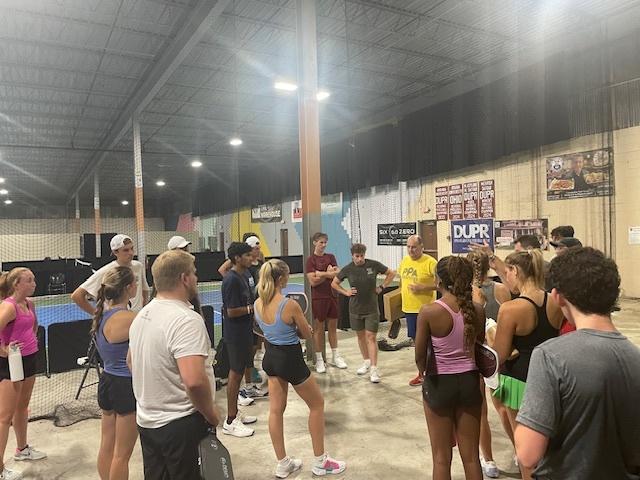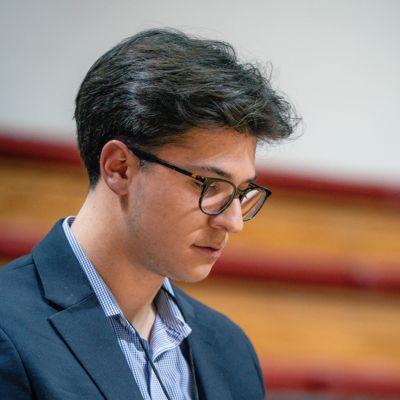Timber Tucker ordered his usual from Gables Bagels: a blueberry bagel with strawberry cream cheese.
He sat at his usual wooden booth: in the middle of three tables stationed to the right of the shop’s entrance. But Tucker wasn’t here for his usual breakfast. It was his first major stop on the recruiting trail as the head coach for Indiana University’s club pickleball team.
Across from Tucker sat an enticing prospect who could help catapult Indiana into the national realm: Carter Wittendorf.
Before coming to IU, Wittendorf was the highest ranked 18-year-old pickleball player in the country. Tucker met Wittendorf previously at a tournament in Washington, Indiana, and was eager to bring his talents to the club.
So, Tucker did what any sensible coach would do — set up a recruiting meeting. Tucker delivered his pitch on the club’s vision; Wittendorf was sold.
The first domino had fallen. Tucker later joked with Gables owner Ed Schwartzman that there should be a plaque at that table.
But the breakfast didn’t end with just Wittendorf’s pledge. By sheer coincidence, IU doctoral student Mehvish Safdar wandered into the shop as Tucker and Wittendorf were chatting. Safdar previously played collegiate tennis at the University of Minnesota and found Tucker’s name online, pursuing her newfound interest in pickleball.
Tucker invited her to sit down and bought her a bagel.
The formation of the country’s ninth-ranked college pickleball team was born.
“For the cost of two bagels, I signed easily what you would call two five-star recruits,” Tucker said.
•••
Pickleball carries a mixed perception. Wittendorf calls it the “toned-down grandma tennis.”
Still, the sport continues to accelerate in popularity, in part due to its accessibility for different levels of athletes. With significantly smaller courts than tennis, lighter paddles and generally less intense activity, pickleball can be played at a slower pace with a focus on precision.
For Wittendorf, however, pickleball is more than a leisurely activity.
He hopes to find an avenue to play professionally. Unlike most of the team, Wittendorf didn’t come from a tennis background. He grew up playing ping pong in his basement with his father and brother, and early in high school started playing pickleball for fun at his local courts in Granger, Indiana.
At his orientation the summer before his freshman year of college, Wittendorf heard about the club while researching what he wanted to be involved in. He met with the team at RCA Park, and two years later, competed with Safdar, senior Thea Bertolini and former club president Sam Hutner in the club’s first tournament in Michigan in October 2023, where Indiana won a DUPR Regional Championship.
During practice one night in mid-September, Wittendorf is teamed with Hutner, now a senior, on the top court. Rather than dinking the ball near the net and methodically placing shots, they clobber them. Wittendorf leaves the court drenched in sweat, his maroon compression shirt more than a few shades darker than when he began.
Practices are well regimented, with singles and doubles games persisting for over an hour. But despite the team’s emergence and Wittendorf’s success, he’s finding the perceptions hard to shake.
“I don’t know about ‘cool,’” Wittendorf said. “But it’s definitely the thing I’m known for.”
•••
Inside Tucker’s office, just to the right of his desktop, there’s a perforated, plastic white ball affixed to a mini wooden paddle. The paddle is decorated with an IU trident and the Hoosiers’ cream and crimson colors.
On the wall behind him, there’s a slightly larger wooden paddle with grip tape showing signs of wear. The small, gray insignia on the paddle denotes the pickleball team’s victory over Purdue last February.
As an ode to the Old Oaken Bucket — awarded to the winner of Indiana and Purdue’s annual football clash — Tucker dubs this the “Old Oaken Paddle.”

Outside Tucker’s office at The Warehouse, an indoor recreation center in Bloomington, IU Pickleball is holding one of its first practices since tryouts. Hutner said tryouts garnered roughly 180 attendees.
Around 30 members are on hand for this practice, sprawled around the eight courts and screeching their tennis shoes on the concrete. Surrounding the courts is an eccentric collection of old video cameras, a stack of four Bibles and, behind the furthest court from the entrance, a blue and white Suzuki motorcycle.
This is the club’s sanctuary.
“We’ve got championship courts with championship nets in an old, drafty warehouse,” Tucker said.
Tucker keeps a watchful eye on Hutner and the top court. Before each serve, Hutner takes a few quick bounces off his toes before plunging into action.
By the time the doubles match concludes, Hutner exits through the black netting to get a splash of water. His olive green Under Armour shirt is soaked, and beads of sweat drip from his forehead.
Hutner founded the pickleball club his freshman year. Tucker calls him the “OG.” To celebrate a recent partnership with Six Zero Pickleball, an Australian based pickleball equipment brand, Tucker decides to gather the team after practice and award a piece of merchandise.
It only made sense for the branded bag to go to Hutner.

Hutner didn’t grow up playing pickleball. He reckons he started playing around his senior year of high school, when a back injury sidelined him from tennis and all but dissolved his chances of playing the sport collegiately.
When he was a kid, even before tennis, the Fort Wayne, Indiana, native had different aspirations.
“I wanted to be an IU basketball player,” Hutner said. “Sadly, I stopped growing at the magical height of 5-foot-7.”
Hutner became embedded within the nation’s pickleball explosion in recent years. While only competing casually for the first two years of Hutner’s presidency, the club ascended in his third.
Tucker’s bagel recruiting strategy evidently succeeded.
IU pickleball garnered two regional and two national championships in Dynamic Universal Pickleball Rating (DUPR) tournaments throughout the 2023-24 year. Safdar won titles in both Women’s Singles and Mixed Doubles. Most recently, the club took home NCPA Regional Championship honors in Cincinnati, hanging a fifth banner inside The Warehouse.

With Indiana firmly inserted into the top echelon of collegiate pickleball, Hutner and Tucker are thrilled to see their vision come to fruition.
Tucker — an IU alum from Evansville, Indiana — doesn’t think the growth of the sport has peaked. But as pickleball continues to be America’s fastest-growing sport for the third consecutive year and money becomes more of a factor, Tucker hopes to maintain some of the sport’s purity.
“When that happened at the pro level, it’s really, really messy,” Tucker said. “People don’t like each other. There’s been a big money grab, it’s just been ugly. And there’s such a sweet spirit to college pickleball. I’ve been trying to be an advocate for that.”
•••
While there are still sentiments of “toned-down grandma tennis,” the sport is rapidly becoming professionalized at colleges nationwide. Tucker said at the University of Virginia — the No. 6 ranked team in the nation — the club enlisted law students to mull over sponsorship contracts and a professional agent to represent the school.
At IU, the primary obstacle is traveling costs. Six Zero Pickleball offered $5,000, but that’s merely a small fraction of what the club requires for flights and hotels.
“I was like ‘thank you, that’s one and a half tournaments,’” Tucker said with a laugh. “But if you want to solve my travel problems, that’s like 40 grand.”
While it would’ve been previously inconceivable, pickleball has become an official sport at different colleges. Drury University in Springfield, Missouri, announced last November the addition of pickleball as a varsity sport, including a full-time head coach, scholarship opportunities and an on-campus training facility.
That’s a bit more unlikely for Tucker and Indiana, namely due to the discrepancy in student population. Drury had a total enrollment of 2,268 students for the 2023 fall semester, whereas IU had 36,833.
There’s considerably more bureaucratic and financial red tape for Indiana to overcome, and Tucker doesn’t see the sport reaching the NCAA level or varsity status in the near future. But that isn’t curbing pickleball’s growing legitimacy.
“It’s not old man pickleball,” Tucker said. “In the last couple of years, the game has totally changed.”
•••
Now peer just outside Tucker’s office at The Warehouse. Hung on the wall behind a large water cooler, there’s a crimson-colored clock with mini-IU paddles and white pickleballs indicating the hours.

Practice is winding down, but the club’s top players aren’t slowing. On the court with Hutner and Wittendorf is sophomore Michael Asplund, a former four-year All-Conference and All-District tennis player at Bloomington High School South.
Asplund is lean and athletic, standing at 6-foot-2 and whacking pickleballs around the court. He considered continuing his tennis career at a small school but opted for IU in large part because of the Kelley School of Business.
As a freshman last year, Asplund starred for the club, winning the DUPR Mixed Doubles title alongside Safdar. He’s already competed in professional qualifiers, too.
He craves competition. Asplund said playing pickleball allows him to tap into the edge he possessed in tennis, and this year’s club is as competitive as it’s been. There are more regimented training sessions, and the addition of top freshmen will only add to the level of play.
“I think last year we had a little too much fun at practice,” Asplund said. “They’re implementing all this, so it’ll be better this year. But we’ll still have fun.”
Fun. It’s the driving reason why Tucker believes pickleball isn’t just a fad. He cited racquetball, which peaked in popularity in the 1970s and 1980s, as being too hard on the body.
But pickleball’s being played everywhere from elementary schools to retirement communities. There may be elements of “toned-down grandma tennis,” but that doesn’t mean it won’t stick in Indiana, and around the country.
“The socialness of it, I think,” Tucker said, “is why it will have lasting power.”
Like what you're reading?
Support independent, award-winning student journalism.
Donate.


